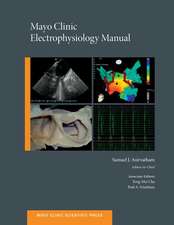Ambulatory Monitoring: Cardiovascular system and allied applications Proceedings of a workshop held in Pisa, April 11–12, 1983. Sponsored by the Commission of the European Communities, as advised by the Committee on Medical and Public Health Research: Developments in Cardiovascular Medicine, cartea 37
Editat de C. Marchesien Limba Engleză Paperback – 12 oct 2011
Din seria Developments in Cardiovascular Medicine
- 5%
 Preț: 1484.50 lei
Preț: 1484.50 lei - 5%
 Preț: 375.17 lei
Preț: 375.17 lei - 5%
 Preț: 354.10 lei
Preț: 354.10 lei - 5%
 Preț: 1419.03 lei
Preț: 1419.03 lei - 5%
 Preț: 376.43 lei
Preț: 376.43 lei - 5%
 Preț: 1098.27 lei
Preț: 1098.27 lei - 5%
 Preț: 1438.38 lei
Preț: 1438.38 lei - 5%
 Preț: 376.78 lei
Preț: 376.78 lei - 5%
 Preț: 368.37 lei
Preț: 368.37 lei - 5%
 Preț: 380.25 lei
Preț: 380.25 lei - 5%
 Preț: 2117.58 lei
Preț: 2117.58 lei - 5%
 Preț: 367.28 lei
Preț: 367.28 lei - 5%
 Preț: 366.56 lei
Preț: 366.56 lei - 5%
 Preț: 371.10 lei
Preț: 371.10 lei - 5%
 Preț: 370.94 lei
Preț: 370.94 lei - 5%
 Preț: 783.18 lei
Preț: 783.18 lei - 5%
 Preț: 713.18 lei
Preț: 713.18 lei - 5%
 Preț: 1098.27 lei
Preț: 1098.27 lei - 5%
 Preț: 375.49 lei
Preț: 375.49 lei - 5%
 Preț: 373.47 lei
Preț: 373.47 lei - 5%
 Preț: 723.93 lei
Preț: 723.93 lei - 5%
 Preț: 1104.13 lei
Preț: 1104.13 lei - 5%
 Preț: 2117.20 lei
Preț: 2117.20 lei - 5%
 Preț: 716.09 lei
Preț: 716.09 lei - 5%
 Preț: 372.03 lei
Preț: 372.03 lei - 5%
 Preț: 722.33 lei
Preț: 722.33 lei - 5%
 Preț: 660.07 lei
Preț: 660.07 lei - 5%
 Preț: 375.34 lei
Preț: 375.34 lei - 5%
 Preț: 1423.22 lei
Preț: 1423.22 lei - 5%
 Preț: 715.35 lei
Preț: 715.35 lei - 5%
 Preț: 790.69 lei
Preț: 790.69 lei - 5%
 Preț: 720.68 lei
Preț: 720.68 lei - 5%
 Preț: 3185.49 lei
Preț: 3185.49 lei - 5%
 Preț: 1418.27 lei
Preț: 1418.27 lei - 5%
 Preț: 784.64 lei
Preț: 784.64 lei - 5%
 Preț: 714.63 lei
Preț: 714.63 lei - 5%
 Preț: 370.74 lei
Preț: 370.74 lei - 5%
 Preț: 376.22 lei
Preț: 376.22 lei - 5%
 Preț: 660.85 lei
Preț: 660.85 lei - 5%
 Preț: 368.37 lei
Preț: 368.37 lei
Preț: 367.58 lei
Preț vechi: 386.93 lei
-5% Nou
Puncte Express: 551
Preț estimativ în valută:
70.34€ • 73.62$ • 58.54£
70.34€ • 73.62$ • 58.54£
Carte tipărită la comandă
Livrare economică 27 martie-02 aprilie
Preluare comenzi: 021 569.72.76
Specificații
ISBN-13: 9789400960145
ISBN-10: 940096014X
Pagini: 440
Ilustrații: 436 p.
Dimensiuni: 156 x 244 x 23 mm
Ediția:Softcover reprint of the original 1st ed. 1984
Editura: SPRINGER NETHERLANDS
Colecția Springer
Seria Developments in Cardiovascular Medicine
Locul publicării:Dordrecht, Netherlands
ISBN-10: 940096014X
Pagini: 440
Ilustrații: 436 p.
Dimensiuni: 156 x 244 x 23 mm
Ediția:Softcover reprint of the original 1st ed. 1984
Editura: SPRINGER NETHERLANDS
Colecția Springer
Seria Developments in Cardiovascular Medicine
Locul publicării:Dordrecht, Netherlands
Public țintă
ResearchCuprins
1: Transducers and Analysis Systems for Ambulatory Monitoring.- 1.1 Sensors for Electrophysiological signals monitoring.- Silicon sensors for electrophysiological signals monitoring.- Discussion.- 1.2 Transducers for long term hemodynamic signals monitoring.- Sources of error in direct and indirect blood pressure measurements.- Air-chamber sensing for blood pressure monitoring.- 1.3 Review of existing systems for ECG ambulatory monitoring.- Review of commercially available systems for ambulatory monitoring.- Review of ambulatory monitoring systems developed at research institutes.- Discussion.- 2: Clinical Applications.- 2.1 Ambulatory monitoring of arrhythmias.- The clinical use of ambulatory monitoring in arrhythmia evaluation.- Computerized arrhythmia analysis of the Holter recordings.- Clinical significance of ventricular premature beats.- Discussion.- 2.2 Ambulatory monitoring of ischemic patients.- Ambulatory ST segment monitoring: past and future.- Significance of electrocardiographic changes in acute transient myocardial ischemia.- Prevalence and magnitude of ST segment and T wave abnormalities in healthy adult subjects during continuous ambulatory electrocardiography.- Discussion.- 2.3 Ambulatory monitoring of hypertensive patients.- Clinical value of non-invasive ambulatory blood pressure measurements and comparison with other methods.- Continuous blood pressure monitoring in the clinical evaluation of hypertensive patients and in the study of neural cardiovascular control.- Combined ECG and intra-arterial blood pressure analysis for the beat to beat evaluation of the systolic time intervals in ambulatory patients.- Discussion.- 2.4 Aspects of the organization of the ambulatory monitoring.- Multilevel organization of ambulatory monitoring units.- 3: Recent Advances of Methods for the Ambulatory Monitoring of the Cardiovascular System.- 3.1 Algorithms for cardiac cycle detection.- Algorithmic approaches to QRS detection.- Performance comparison of fast QRS detection algorithms.- Discussion.- 3.2 Feature extraction for ECG waveforms characterization.- Feature extraction from ECG waveforms; techniques used by automatic analysis systems and clinical observers compared and contrasted.- Parameter extraction for automatic analysis of ECG traces.- Discussion.- 3.3 Feature extraction for hemodynamic signals characterization.- Ambulatory blood pressure signal features: identification, measurements and implications.- How shall we analyse the ambulatory blood pressure signal?.- Discussion.- 3.4 Algorithms for the classification of biological signal waveforms.- Pattern recognition in biological signals.- Algorithms for wave form classification.- Algorithms for ECG waveform analysis and classification.- Discussion.- 3.5 Portable real time processors versus playback systems.- Ambulatory Monitoring: Real time analysis versus tape scanning systems.- 3.6 Evaluation of ambulatory monitoring systems: experiences and perspectives.- Evaluation of automated arrhythmia monitors using an annotated ECG database.- Clinical experience with a system based on analysis of R-R interval patterns.- Pilot study and preliminary experiences with a data base for the evaluation of algorithms for the detection of arrhythmic and ischemic episodes.- Discussion.- 4: Further Applications of Ambulatory Monitoring and Technological Perspectives.- 4.1 Monitoring of non cardiovascular signals.- Ambulatory monitoring of neurophysiological signals, art or artefact.- Long term respiration monitoring and its relevance to cardiovascular monitoring.- Discussion.- 4.2 Emerging technologies.- The potential of VLSI in Ambulatory monitoring.- Discussion.- Appendix: Presentation and Discussion of a Proposal for a Concerted Action on Ambulatory Monitoring.- Discussion, chairman: C. Marchesi.









